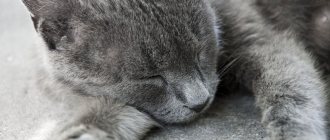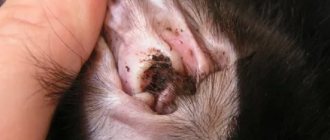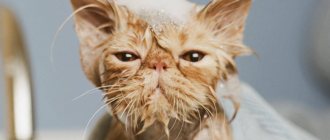EOSINOPHILIC SYNDROME is an inflammatory disease of the skin and mucous membranes that occurs due to hypersensitivity or allergies to insect bites, food, etc. The syndrome includes the following diagnoses: eosinophilic granuloma, eosinophilic ulcer, eosinophilic plaque, allergic miliary dermatitis. The syndrome develops as a result of the activity of eosinophil cells - one of the types of leukocytes that “pounce” on the foreign component and try to neutralize it. The result is swelling and/or ulceration of the tissue. The syndrome can also manifest itself in the form of papules, rashes, and crusts, not only on the lips, but also in any other place on the body.
The veterinarian explained that for cats this is a normal phenomenon similar to human herpes: granuloma can occur spontaneously and then go away on its own. To speed up the process, he injected steroids, which forcibly suppressed the body’s unwanted reaction. And he added that the injection will last about ten days, after which a second one may be needed. And we, reassured, went home.
The lips began to shrink and after a couple of days returned to their previous state. But the question of why this suddenly happened could not leave my mind. I believe that nothing, including eosinophilic granulomas, occurs without a cause, although there is the so-called idiopathic cat granuloma, when the cause could not be found out. However, the fact that it could not be found out does not mean that there is no reason. And I set out to understand why a young healthy cat suddenly developed this attack? If the veterinarian’s explanation “this is a type of herpes in people that appears when immunity decreases” is taken as a basis, it turns out that the cat’s immunity has decreased. But there were no apparent reasons for this. It was beautiful spring weather, the house was warm, there were no drafts, the cat was young, she was eating better than us, and in general she was running and jumping, being active and not worrying about her lips in any way. In general, it did not look like immunity problems.
I started searching the Internet again, already knowing the diagnosis. And, as it turned out, I was not mistaken: there was a root cause after all. And since I didn’t find or eliminate it in the 10 days that we were given for recovery, after this time my lips began to grow in size again. I didn’t want to take the second injection anymore, because it became clear that there would be a third and a fourth, and then the problem might go away, but after a while it would come back again if the root cause was not eliminated. Even then, injections seemed to me only symptomatic therapy (and now I know this for sure), which in large quantities could also lead to other health problems.
More about eosinophilic granuloma
Feline eosinophilic granuloma can occur not only due to decreased immunity, but also due to allergies and bacteria. I started analyzing. As I already said, our immunity was clearly all right. Allergies and bacteria remained. And then I remembered what preceded the appearance of Angelina Jolie’s lips on my cat.
Firstly, she found her way to a ficus tree on the closet and started gnawing on it. And ficus is known to be toxic to cats and can cause allergies and stomatitis. If you've ever trimmed the leaves of a ficus tree, you know that it produces a pungent white sap. Secondly, a couple of weeks before the problem arose, I bought a large plastic water dish for the cat, because... I read that cats love large transparent containers and drink more actively from there. Plastic is sometimes toxic, and it also has large pores where food and water residues get clogged and where bacteria subsequently develop, terrorizing the mouth of a cat drinking from plastic. Thirdly, even to normal plastic there is an individual allergic reaction.
I did not check all the versions one by one to understand which one was correct. I immediately excluded both ficus and plastic dishes from the cat’s life. After just 4 days, there was no trace left of the swollen lips. As I realized later, the problem most likely was a reaction to bacteria in the pores of the plastic, because... She got to the ficus several times after that, but there was no more reaction, plus at that moment my cat also developed acne. I didn’t notice it right away, and the vet didn’t see it at all (or didn’t pay attention to it).
Externally, acne resembles dirt crushed onto the chin. By the way, at first I thought that the cat was rummaging in the flower pot. But then, while studying veterinary articles, I realized that it was acne. So, after eliminating the plastic container, the acne went away along with the granuloma. Coincidence? Don't think.
ACNE IN CATS is a skin disease in which the sebaceous glands become inflamed and clogged. Acne occurs as a result of stress, poor hygiene, abnormal development of the sebaceous glands, decreased immunity and (attention!) the use of plastic bowls when feeding. Sometimes acne is accompanied by a secondary infection. As a result, the area of skin with acne may become bald, itching, ulcers and swelling may appear on it.
In our case, it was enough to remove the plastic bowl, because... no secondary infection joined the process and there were no ulcers or pus. If an infection were to occur, antibiotics and treatment of the affected area with an antiseptic (chlorhexidine is often used) would be needed. And in cases where acne appears as a reaction to an allergen and it is not possible to calculate it yourself, it is necessary to carry out allergy tests or exclude one factor after another with an interval of about 1 week and wait to see which one works.
Granuloma and acne have other causes. Often these are hormonal surges that cats experience during estrus, pregnancy and childbirth, and male cats - during the rut. In this case, if the animal is not planned to be used for further breeding of kittens, castration helps.
The takeaway from this situation is that many veterinarians follow a simplified protocol that does not always involve calculating the cause of the syndrome. It's much easier to give an injection. Moreover, in our case, the doctor did not notice the acne, which means he simply did not conduct a quality examination. If you encounter the same veterinarian, you need to use your own logic. Think about what could have been the trigger (all factors in the last 2-3 weeks). Try eliminating different factors and check the result. In the end, only you are responsible for your pet's health.
However, I do not encourage you to make a diagnosis yourself, but I advise everyone who is faced with the problem of a swollen lip in a cat to immediately go to a good veterinary clinic, and here’s why. The fact is that a swollen lip in a cat can be a symptom not only of eosinophilic granuloma, but also of the following diseases.
Possible reasons
Often, even attentive owners do not immediately notice a swelling on the lip. Having discovered it, the question arises as to what is the reason why the cat’s lower lip is swollen.
© shutterstock
The most common reasons why cats may have a swollen lower lip:
- Introduction of dry food into the diet . Cats may develop a callus on their lower lip due to the unusual consistency of the food. Hard granules rub the lip, and this leads to swelling.
- Trauma . A cat can injure its lower lip during active play. This can happen either during a fall from a height, or when colliding with objects, or when trying to chew on a hard toy.
- Bite of another animal . This happens quite often if the cat is outdoors, where it comes into contact with other animals. This can also happen if, in addition to the cat, other pets live in the house. Animal games can be quite active and aggressive.
- Insect bite . A cat can be bitten by various insects - bees, wasps, horseflies.
- Allergic reaction . A cat can be allergic to different things. It can occur due to contact with household chemicals, flowers, plants, new food and various other irritants. Various parasites can also be the cause: helminths, fleas and ticks.
- Viral infection . It is expressed in the presence of small blisters on the oral mucosa that may resemble herpes.
- Tumor or cyst of the salivary glands . Occurs due to injury to the salivary glands. This may occur due to injury to the lower lip.
- Malignant tumor . Cancer can affect any tissue in the mouth. It can also affect the lower lip. The swollen lip will feel hard to the touch.
- Acne . You may notice black dots on a swollen lip. They are often accompanied by the presence of small pimples. When the disease is advanced, crusts, inflammation, ulcers, nodules, and extensive redness can be observed on the lower lip and chin. When touched, pain may occur.
How to determine the disease?
More often the upper lip is affected on the right or left, less often on both sides at once. The ulcer has a clearly defined outline, its color is closer to brown, its size is 0.2-5 cm. There is no itching or pain, the pet clearly feels discomfort only at the time of eating or drinking. Therefore, the owner may notice that the pet has begun to avoid bowls. Additionally, the following can be found on the surface:
- plaques;
- miliary dermatitis;
- granulomas.
The same patient may experience different manifestations simultaneously. The localization of various manifestations of the disease can be: the abdomen or thigh, back or neck, lower lip or gums.
To exclude further manifestations of allergic dermatitis, it is recommended to conduct a special test. It will allow you to identify the problem to which the body develops a negative reaction. Often, tailed pets are allergic to dust, tobacco smoke, pollen, and mold.
How to cure a pet?
Of course, treatment does not need to begin until a final diagnosis is made. Each of the described conditions requires an individual treatment regimen. The drug Dexamethasone is often used to treat conditions that cause swollen lips and lesions in the mouth. Dexamethasone has the active ingredient dexamethasone disodium and is available in the form of injection ampoules. Dexamethasone has anti-inflammatory, anti-allergic and anti-shock effects.
In case of infectious lesions, Dexamethasone complements antibiotics. Dexamethasone should be given in the dosages specified in the instructions for use. Another drug that has a detrimental effect on a number of pathogenic microorganisms is Sinulox. Sinulox is available in the form of a suspension or tablets. Sinulox is effective for infectious lesions of soft tissues and mucous membranes. Sinulox is often prescribed for gingivitis. Sinulox should be given strictly according to the instructions for use. There is a tablet form of Sinulox.
>Photo gallery The request returned an empty result.
What does it come from?
In most cases, such manifestations on a cat’s upper lip are the result of an allergy. The causes of a rash on the oral mucosa may be:
- Insects and mites that live on the pet's body. This includes fleas and other ectoparasites (lice, ear mites).
- Medications. The recently introduced vaccine may also cause a similar effect.
- Food. Preservatives, dyes and other ingredients found in inexpensive pet food can cause allergic dermatitis in the form of rashes on the upper lip.
If a cat has a swollen upper lip, then in order to help it, it is suggested to first identify the pathogen.
The cat's lower lip is swollen: how to treat it
Before starting treatment, a preliminary diagnosis is made based on clinical symptoms and analysis. If clarification is required, a blood test, microscopy of the skin, and histological examination of the affected tissues are prescribed.
Without waiting for the results to be deciphered, the following measures are taken:
- if the tumor is caused by injury, use external antiseptics or anti-inflammatory drugs;
- if an allergy is suspected, tests are performed to identify the irritant;
- replace plastic dishes with ceramic ones;
- transfer pets to hypoallergenic food with food of at least premium class; if dry granules interfere with food consumption, they are replaced with wet canned food;
- if the pet’s condition rapidly deteriorates, immunomodulators, oral or injectable drugs are used.
Treatment is carried out depending on the diagnosis. Professional medical and veterinary preparations are used.
Traditional methods are ineffective, but at the discretion of the veterinarian they can be used in the form of external agents when the treatment is long-term and a pause must be made in the use of basic medications.
Eosinophilic granuloma
If an eosinophilic granuloma is diagnosed, long-term therapy with antimicrobial agents is carried out for up to 20 days. Steroid and non-steroidal anti-inflammatory drugs are used. The affected area is lubricated with external agents, if necessary.
The following antimicrobial drugs are in demand in injectable, oral or external form:
- Gentaprim;
- Trimethoprim;
- Levomekol;
- Sulfetrisan;
- Doxycycline.
Glucocorticoids relieve inflammation and eliminate itching. The duration of use of the medicine and its dosage is determined by the age and physiological state of the animal. Elderly pets are prescribed long-term steroid therapy in doses reduced by half. The drugs are injected 2 times a month until recovery.
The following corticosteroids are in demand:
- Hydrocortisone;
- Dexamethasone;
- Prednisolone.
Be sure to read:
Seizures in a cat: physiological and pathological causes, symptoms, first aid, treatment
If the cause of the granuloma is a tumor, chemotherapy is used. In mild cases, antihistamines or antipruritic drugs are used - Stop Itching and analogues.
Gingivitis
If the cause of a tumor on the lip is Gingivitis, teeth are cleaned with special brushes or special devices in a clinic. Clean off plaque or tartar. Glucocorticosteroids are used to relieve inflammation. At the discretion of the veterinarian, use antimicrobial agents from the same list as in the treatment of eosinophilic granuloma.
To relieve pain symptoms, medical gels Metragil-Denta or Dentamed, veterinary drugs Dentavedin or Zubastik are used. If there is no progress, the tooth is removed.
Acne
The disease develops against the background of unsatisfactory condition of the feeding utensils. Contaminants from the surface of the plastic bowl migrate to the cat's chin and lip, forming blackheads. For treatment, prepare the damaged surface for applying the medicine. The wool is cut, the crusts are soaked, and dirt is removed using antiseborrheic shampoo.
The following antiseptic and wound healing agents are used:
- Benzamycin;
- Salicylic acid;
- Benzoyl peroxide;
- Tincture of calendula;
- Retinoids, which contain vitamin A.
Change your diet. Avoid fatty foods and table scraps.
Infectious diseases
With prolonged antibiotic therapy, fungal stomatitis develops, which is characterized, in addition to damage to the lips, by a gray-white coating on the tongue. Antiseptic, wound-healing and antifungal drugs are used, which are prescribed by a veterinarian.
A dangerous viral disease of cats - Calicivirus is characterized by the formation of ulcers on the tongue and lesions of the lips. Immunomodulators are used for treatment - Catozal, Immunofan, Fosprenil, Maxidin. The mouth and lips are sanitized with Chlorhexidine, Furacilin, and Lugol's solution. Symptomatic remedies are used depending on additional signs of the disease - arthritis, conjunctivitis.
Tumors
Neoplasms are treated surgically. Benign tumors are removed; treatment of malignant tumors is impossible. Surgical sutures are lubricated with antiseptic agents.
Nose injuries
The nasal planum is an organ that provides the domestic predator with a significant amount of information about the surrounding world. When getting acquainted with something new, a cat carefully sniffs the object. She does the same with new pets or guests. By touching the owner’s hands and shoes and his things with his nose, the animal “reads information” about where the person has been, with whom he has been in contact, and what he has touched.
By sniffing food, the little hunter determines not only its freshness and edibility, but also its temperature. Injuries to the nasal planum are possible both in a pet that is allowed outside and in a couch potato.
A sore on a cat’s nose can appear after a fight with relatives, an unsuccessful jump from a height, or sniffing thorny indoor plants. Pets that live in the same house from a young age often do not perceive each other as links in the food chain. They play, communicate with each other, and not always neatly.
In case of a minor injury or ulcer on the nose, the cat can be treated by lubricating the nasal planum with vegetable oil, such as sea buckthorn or olive. A little tea tree essential oil is first added to olive oil (2-3 drops per 1 tsp), which improves wound healing and helps suppress the activity of microorganisms (bacteria, viruses, fungi). Before the procedure, you can lightly wash the wound by touching it with a cotton pad soaked in a pale pink solution of potassium permanganate (potassium permanganate).
If there is no effect from home treatment within 3-5 days, a veterinarian will help cure the small predator. Perhaps an infection has joined the injury or there is an allergic reaction to something.
Inflammation of the gums and dental pathologies
Dental diseases are very often accompanied by slight swelling of the lip border and oral mucosa. The most common cause of enlargement of the lower lip is gingivitis - inflammation of the gums. The causes of gingivitis are weakened immunity, mucosal injury, and food allergies.
Characteristic symptoms:
- bad breath;
- red border around teeth;
- loss of appetite;
- increased saliva production;
- swelling of the gums and lips.
Older animals or cats whose bodies are weakened by a long-term illness are more likely to experience gingivitis. This disease requires treatment as it can lead to tooth loss.
Gingivitis is treated with medication, using topical agents. As a rule, special gels or ointments with an antibiotic and an anti-inflammatory component are prescribed. Plaque must be cleaned and tartar removed. Additionally, medications are prescribed to enhance immunity.
Diagnosis and identification of causes
In some cases, the owner can independently determine the reason that the lower lip is slightly enlarged and swollen. This is possible in cases where it is reliably known about an injury, an insect bite, or the presence of an allergic reaction.
You should not self-diagnose or diagnose an animal with a swollen lip. The swelling may not cause concern to the owners, but, unfortunately, the pet is not able to communicate about its sensations and the possible causes of this condition. Therefore, if your cat has a swollen lower lip, you should seek medical help. A qualified specialist will be able to reliably determine the cause of this condition and prescribe treatment.
In most cases, a simple visual inspection of a cat with a swollen lip will be sufficient. The doctor may also take a sample of biomaterials for analysis to determine the presence of a bacterial or fungal infection. You may also need a blood test to get a more complete picture of your cat's health.
If there is a suspicion of swelling due to a benign or malignant neoplasm, a biopsy, ultrasound and x-ray examination will be required. These measures are necessary to confirm or exclude the presence of tumors, determine their nature, as well as the stage of the disease.
Swollen lips in a cat may indicate a variety of processes in the animal's body .
This alarming symptom should not be ignored. It is better to immediately rule out the presence of a serious pathology than to try to cope with a serious illness later. Owners should not be faced with the question of whether to see a doctor or not.
The cat's lower lip is swollen: what to do?
If the owner, when examining the cat, discovers swelling of the lip, you should check for wounds, calluses, redness or painful areas. Are there any additional symptoms? You should not use medications, especially human ones, on your own. The disease is driven inside and becomes chronic. If a visit to a specialist is delayed, dangerous complications may arise.
Be sure to read:
Mastopathy in cats: causes, how dangerous it is, symptoms of the disease, treatment methods, prevention
But, in some cases, medications are not needed at all. Perhaps the situation will improve if you replace the dishes and switch to a different type of food. If the measures taken do not help, then you should seek qualified help.
Bruises
Another reason why a cat’s upper or lower lip is swollen can be a hematoma. Usually such a problem is preceded by a fall or a slight blow. Treatment consists of applying cold to the bruise. But first you need to make sure that the animal does not have any dislocations or damage to the jaw. Most often, active cats suffer from such bruises. Therefore, owners of animals prone to bruises are advised to learn how to provide first aid and have antiseptic solutions in their veterinary first aid kit.
If a cat spends a lot of time outside, an insect bite can cause swelling. The lip swells very sharply and begins to itch (at the same time the animal may meow for a long time). As first aid, it is recommended to give your pet Suprastin, Loratadine. If home treatment is successful, the swelling will subside within a few hours.
Attention! Bee and wasp stings are deadly for cats with allergies. You should not try to pull out the sting; it is better to immediately take your pet to a veterinary clinic
The cat's lower lip is swollen: associated symptoms
Regardless of the cause of inflammation, swelling develops around the lip. The skin begins to peel, turns red, and ulcerations appear.
The cat has difficulty eating, as well as the following accompanying symptoms:
- loss of appetite or refusal to eat due to pain while eating.
- profuse drooling;
- resistance when the owner tries to examine the mouth and aggressive rumbling;
- bad breath;
- swelling of the muzzle due to inflamed salivary glands;
- the tongue is hyperemic or has a dirty gray coating on it;
- the animal is losing weight;
- the coat loses its shine and becomes disheveled.










